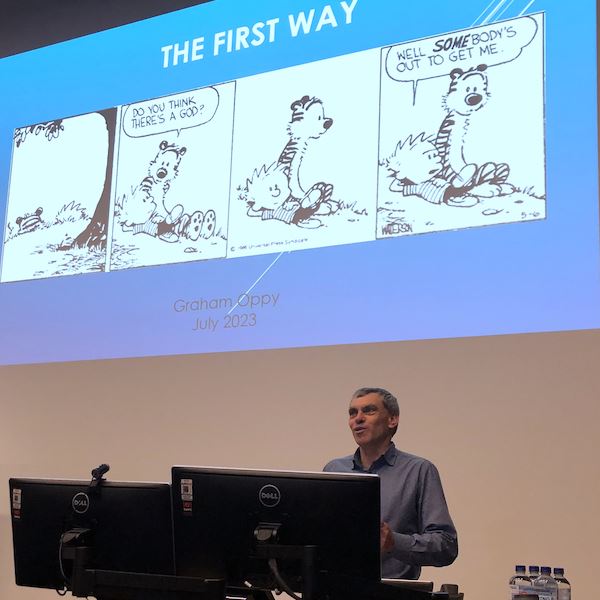2023 PRESIDENTIAL ADDRESS


SUNDAY 2 JULY 4.00pm
Validity and Soundness in the First WayAbstract: We discuss the validity and soundness of arguments that instantiate the formal structure of the first argument in ST 1, Q2, A3:
1. Some things are moving/changing.
2. Nothing moves/changes itself.
3. Whatever is moving/changing is moved/changed.
[4. If one thing moves/changes a second, and the second moves/changes a third, then the first moves/changes the third.]
5. This cannot go on to infinity.
6. (So) There is something that is not moving/changing that moves/changes other things.
We shall begin by attempting to prove that there is a disambiguation of 6 on which it is a logical consequence of 1-5. The proof is in three parts. First, we show, in first-order predicate calculus, that the selected disambiguation of 6 is a logical consequence of 1-4 if we add the assumption that there are no more than four distinct things. Second, we show, using mathematical induction over proofs in first-order predicate calculus, that, for any n, the selected disambiguation of 6 is a logical consequence of 1-5 if we add to them the assumption that there are no more than n distinct things. Third, we interpret 5 to mean that, for some n, there are no more than n distinct things.
Since this interpretation of 5 is sub-optimal, we then attempt to prove that a much stronger claim—namely, the same disambiguation applied to:
7. There is something that is not moving/changing that (non-trivially) moves/changes everything else.
--is a logical consequence of 1-4 if we add the further assumptions (a) that there is a single chain of movement/change or a single tree of movement/change to which everything belongs; and (b) that that single chain or single tree is, in a suitable sense, finite.
Finally, we note (a) that these conclusions—the selected disambiguations of 6 and 7—fall far short of what Aquinas aims to establish; and (b) that stronger disambiguations of 6 and 7 that he might have hoped to be establishing are not logical consequences of 1-5.
So much for validity. When we turn to soundness, we argue first that it is outright mistaken to think that there is just one movement/change chain and highly implausible—in the light of physics—to suppose that there is just one movement/change tree. Then we consider the premises 1-4, along with the following three claims:
8. Some things are moving/changing some things.
9. If there is something moving/changing everything else, then it is not moving/changing.
10. Whatever is moved/changed is moving/changing.
After noting that we could replace 1 and 3 with 8, 9, and 10, without changing any of our conclusions about validity, we argue (a) 4 and 10 are very plausible, if not analytically true; (b) 1 and 8 are very plausible; (c) the combination of 2 and 3 is highly implausible; and (d) it is very hard to motivate 9 if you do not already accept one of the stronger claims that Aquinas had been hoping to establish.
